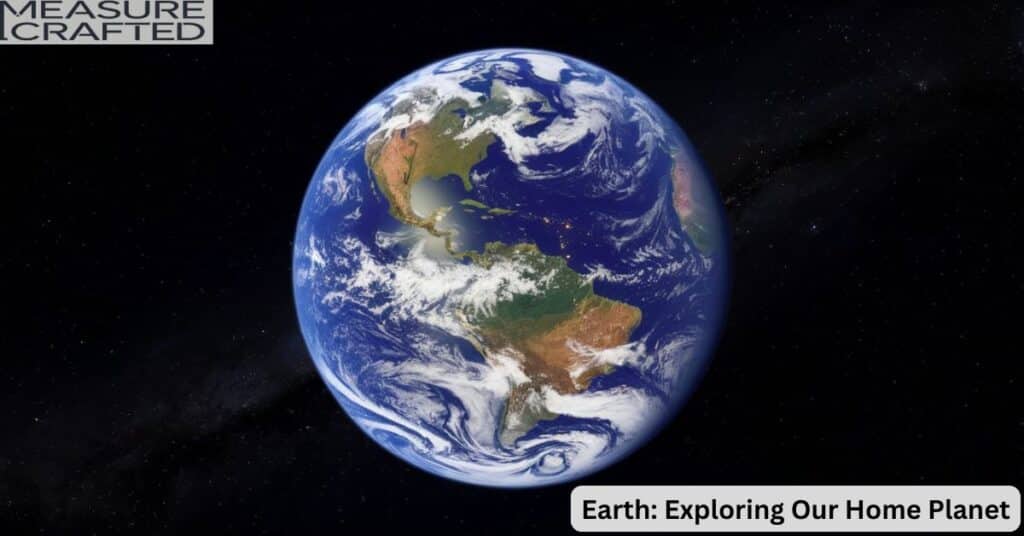Earth is an extraordinarily terrestrial planet in the realm of the solar system. It became well known because it supported life. Some peculiar characteristics such as being full of liquid water, maintaining a stable climate, and having an excellent protective magnetosphere have made it a wonder and an area of study.
This article will discuss the critical aspects of Earth, describing in detail its structure, its orbit, its surface, its atmosphere, and much more.
Understanding Earth
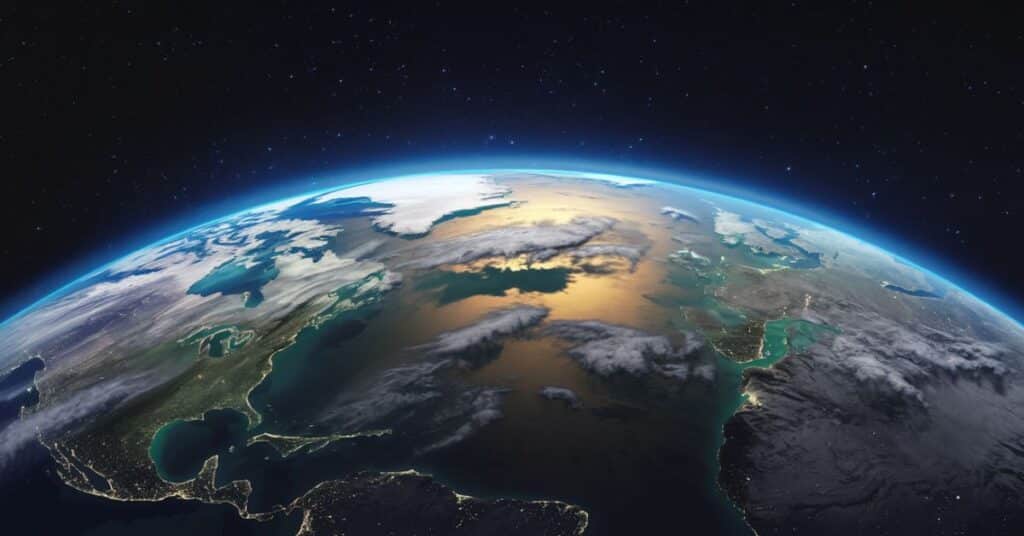
Below are the unique attributes that define Earth and contribute to its position as the only known home for life in our celestial system.
Want to explore furthur, Dead Sea Insights: Dimensions, History, and Surprising Facts
Names of earth Through History
Earth’s name originates from Old English and Germanic words meaning “ground” or “soil”. The term “Earth” comes from the Old English word “eorðe”, and the Germanic word “erde”, both of which referred to the ground or the material world.
Earth stands out as the only planet in the Sun’s system not named after a Roman or Greek deity. In many cultures, Earth has unique names reflecting a deep connection to nature. For instance:
- In Latin, Earth is called “Terra”, used in scientific contexts.
- In Greek, the personification of Earth is Gaia, a primordial deity symbolizing the Earth as a living organism.
- In Sanskrit, “Prithvi” refers to Earth, personified as a goddess.
- In Chinese, people call the Earth “Di” or “Ti,” referring to it as a cosmic force.
Earth’s Habitability
Earth stands out in the celestial system as the only known planet to support life. Its distance from the Sun’s system places it within the habitable zone, where temperatures are just right for liquid water to exist.
This unique position allows for a stable climate that supports life. Coupled with an atmosphere rich in oxygen and nitrogen, Earth fosters a thriving biosphere, where diverse forms of life can flourish.
Earth’s Unique Characteristics
Earth’s equatorial diameter measures approximately 12,742 kilometers (or 7,918 miles), making it the fifth largest planet in the solar system. This size, coupled with its unique structure, allows Earth to maintain a range of climates and ecosystems.
The planet’s axial tilt of 23.5° is another key feature that sets Earth apart. This tilt is responsible for the seasonal cycle, driving variations in temperature and daylight hours throughout the year. The result is the diverse climates and ecosystems that make Earth’s surface so rich and varied.
Earth in the Solar System
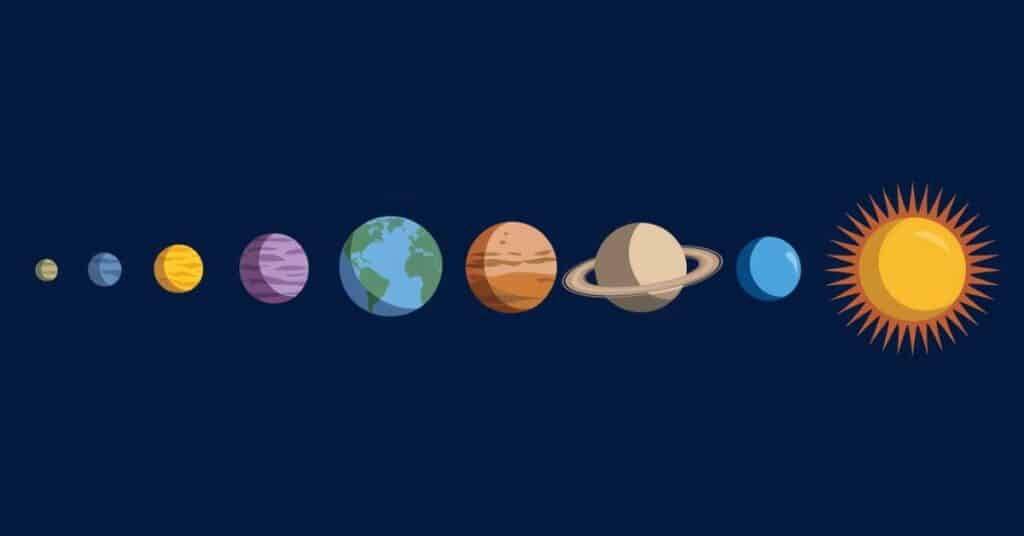
Below are the following unique features and interactions that define Earth’s place in the solar system.
Orbit and Rotation of earth
Earth follows an elliptical orbit around the Sun at an average distance of 149.6 million kilometers (or 93 million miles), placing it in the habitable zone of the solar system. The orbital period, or year, lasts 365.26 days. To account for the extra 0.26 days, a leap day is added every four years, creating a leap year of 366 days.
As Earth rotates on its axis, one full rotation is completed every 24 hours. At the equator, Earth rotates at a speed of 1,037 miles per hour (1,670 kilometers per hour), a speed that decreases toward the poles. This rotation influences the passage of time and helps divide daily activities.
Gravitational Interactions
Earth’s gravitational bond with the Moon, its only natural satellite, stabilizes its axial tilt, influencing seasonal variations and climatic patterns. The Moon’s gravity also drives the tides, impacting marine life and ecosystems.
The gravitational pull between Earth and the Sun governs the planet’s orbital mechanics and energy exchange, which sustains life and drives weather patterns, photosynthesis, and life cycles.
Interested about, How Long is 999 Seconds? Practical Insights and Fun Facts
Earth’s Companions
Below are the key roles played by Earth’s natural satellite and magnetic field in shaping and protecting our planet.
The Moon’s Role
The Moon features craters, maria, and highlands, making it a key focus of scientific exploration. Its lunar orbit is approximately 384,400 kilometers (or 238,855 miles) from Earth, influencing ocean tides and helping to stabilize Earth’s rotation.
This proximity plays a crucial role in driving tidal forces and supporting a stable climate by stabilizing Earth’s axial tilt.
Earth’s Magnetosphere
Although Earth lacks rings, it is protected by a powerful geomagnetic field, known as its magnetosphere, which acts as a shield against harmful solar winds and cosmic radiation. The magnetosphere deflects charged particles from the Sun, preventing them from stripping away Earth’s atmosphere and ensuring the stability of life.
This magnetic field also creates stunning auroras near the poles when charged particles interact with Earth’s atmosphere. These glowing displays are a visible manifestation of the planet’s magnetic protection.
Formation and Evolution
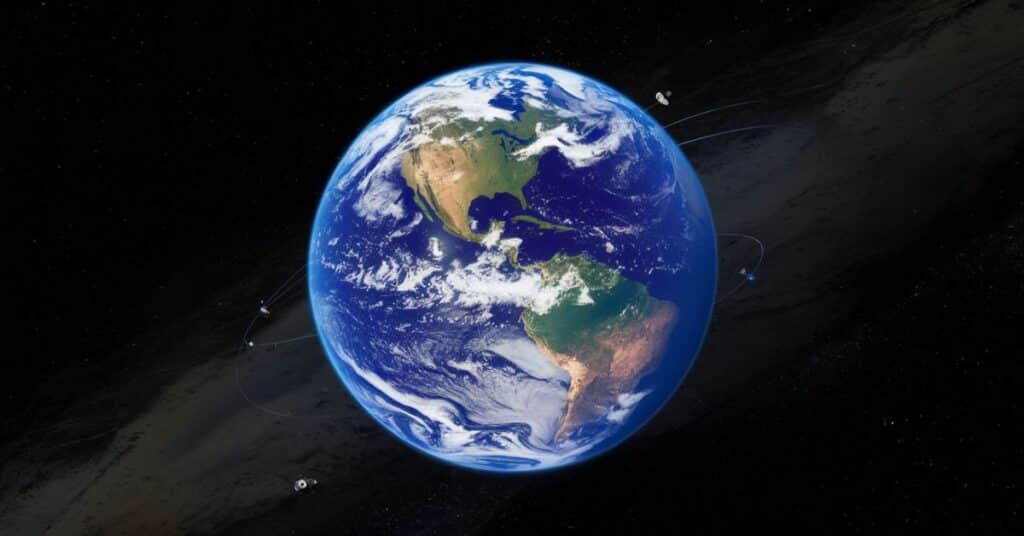
Below is an overview of Earth’s formation and the major stages of its geological history.
The Birth of Earth
Earth formed about 4.5 billion years ago from the solar nebula, a swirling disk of gas and dust. Through the process of accretion, particles gradually clumped together, eventually forming the young planet.
One of the most significant events in Earth’s early history was the Theia collision, a massive impact with a Mars sized body. This collision is believed to have not only contributed to Earth’s formation but also to the creation of the Moon. The debris from this impact eventually coalesced to form Earth’s natural satellite.
Geological Timeline
Earth’s history is divided into four major eons:
- Hadean: Around 4.5 billion years ago, intense volcanic activity and meteorite impacts led to the formation of Earth’s crust, while the atmosphere was still unstable.
- Archean: Starting about 4 billion years ago, early life forms like single celled organisms emerged, and Earth’s crust cooled to form stable landmasses.
- Proterozoic: From 2.5 billion to 541 million years ago, oxygen began accumulating in the atmosphere, supporting the rise of multicellular organisms.
- Phanerozoic: Beginning around 541 million years ago, the evolution of complex life forms, including dinosaurs, mammals, and humans, marked this eon.
Earth’s Structure
Earth is made up of several distinct layers, each with unique characteristics. The composition and features of these layers play key roles in shaping Earth’s geological processes.
Read more, How Long is 20 Feet? 11 Common Things That Are 20ft Long
| Layer | Depth Range | Composition | Key Features |
|---|---|---|---|
| Crust | 0–70 km | Silicate rocks, minerals | Lithosphere, tectonic plates |
| Mantle | 70–2,900 km | Semi solid silicate magma | Convection currents |
| Outer Core | 2,900–5,150 km | Liquid iron and nickel | Generates magnetic field |
| Inner Core | 5,150–6,371 km | Solid iron and nickel | High pressure and temperature |
- Crust: The Earth’s outermost layer, composed of silicate rocks and minerals, is the lithosphere, which forms the tectonic plates that shape Earth’s surface through plate tectonics and volcanic activity.
- Mantle: Beneath the crust, the semi solid mantle contains silicate magma, which moves in convection currents. These currents drive the movement of tectonic plates and contribute to continental drift.
- Outer Core: The liquid outer core is made of iron and nickel. It is responsible for generating Earth’s magnetic field through its motion.
- Inner Core: The inner core is composed of solid iron and nickel and remains under extreme pressure and temperature. It acts as a significant heat source for the planet.
Earth’s Surface and Atmosphere
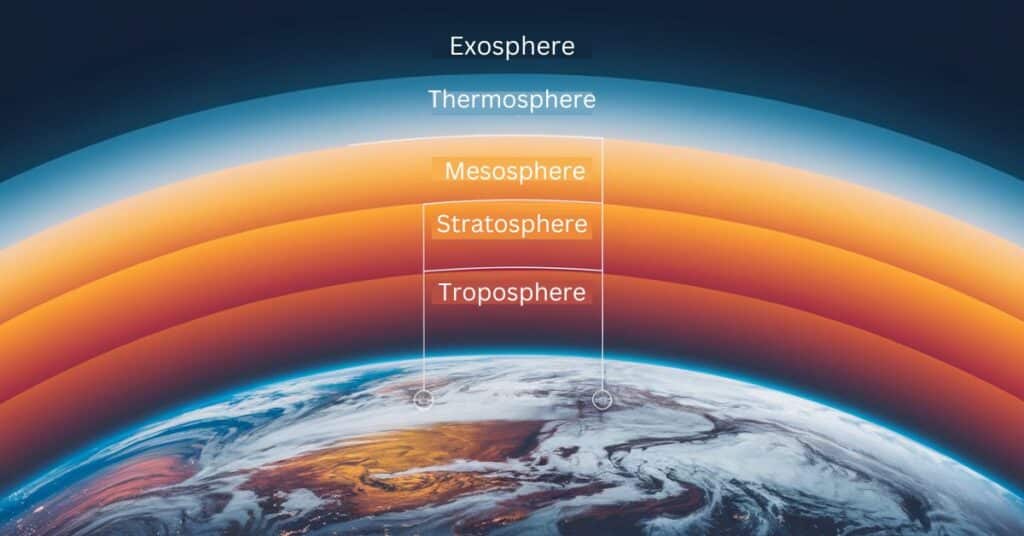
Below is an overview of Earth’s landscapes, water bodies, and atmospheric structure, highlighting their key characteristics and roles.
Below is an overview of Earth’s landscapes, water bodies, and atmospheric structure, highlighting their key characteristics and roles.
Landscapes and Oceans
Earth’s surface is 71% water, including oceans, lakes, and rivers, while the remaining land consists of mountains, plains, and valleys.
Key Features:
- Mount Everest: The highest point on Earth, standing at 8,849 meters (29,032 feet) in the Himalayas.
- Mariana Trench: The deepest point, reaching 10,924 meters (35,856 feet) below sea level in the western Pacific Ocean.
These extremes, along with diverse landforms and aquatic environments, shape Earth’s climate and ecosystems.
Earth’s Atmosphere
Earth’s atmosphere sustains life by regulating temperature and shielding the planet from harmful solar radiation. It is composed of:
- Nitrogen (78%): The dominant gas, maintaining balance for life.
- Oxygen (21%): Essential for respiration and life processes.
- Trace Gases (1%): Includes argon, carbon dioxide, and neon, important for processes like photosynthesis and the greenhouse effect.
Atmospheric Layers:
The atmosphere is divided into 5 layers:
- Exosphere: The outermost layer, where particles can escape into space.
- Troposphere: The lowest layer, where weather and life occur, extending up to 15 km (9 miles).
- Stratosphere: Contains the ozone layer, which absorbs UV radiation.
- Mesosphere: Extends from 50 to 85 km (31-53 miles), where meteors burn up.
- Thermosphere: Known for its high temperatures, it contains the ionosphere, where auroras happen.
Dive deeper into the topic, How far away is the Moon?
Earth’s Climate and Magnetosphere
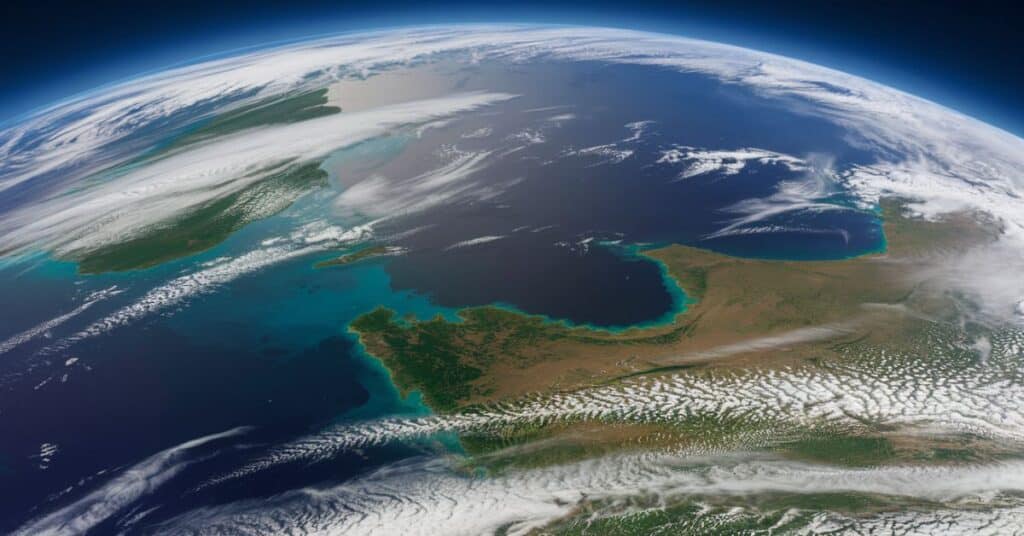
Below is an overview of Earth’s dynamic climate systems and its natural protective shield, the magnetosphere.
Earth’s Climate
Earth’s axial tilt primarily influences its climate, causing seasonal changes in sunlight distribution. This tilt, combined with the planet’s orbit, leads to variations in temperature and weather patterns throughout the year.
Weather Patterns:
- Monsoons bring seasonal rains to South Asia, crucial for agriculture but also causing floods.
- Hurricanes form in warm ocean waters, bringing destructive storms to tropical regions.
Seasonal Cycles:
- Earth’s seasons, driven by its orbit and tilt, affect temperatures, plant growth, and agriculture, influencing global ecosystems.
Magnetic Shield
Earth’s geomagnetic field acts as a protective shield, generated by the movement of molten iron and nickel in the outer core. This magnetic field extends far into space, forming a magnetosphere that deflects charged particles from the Sun, such as solar winds and cosmic radiation, which could otherwise harm life on Earth.
Fascinating Earth Facts
Here are some intriguing details about Earth:
| Category | Details |
|---|---|
| Day Length | 23.93 hours |
| Year Length | 365.26 days |
| Equatorial Diameter | 12,742 km (7,918 miles) |
| Light Time to Sun | 8.3 minutes |
| Average Temperature | 16°C (59°F) |
Excited about, Mount Everest: Earth’s Highest Peak and Its Fascinating World
Earth’s Role in the Universe

Earth, a part of the Milky Way galaxy, plays a pivotal role in humanity’s exploration of the cosmos. Positioned in the solar system, Earth acts as a vantage point for observing and understanding the universe. Through ground based and space based telescopes, scientists have discovered thousands of exoplanets.
These observations have broadened our understanding of the potential for life beyond Earth, fueling research into planetary systems across the galaxy. Earth not only sustains life but also enables the pursuit of knowledge about the vast celestial system in which it resides.
Conclusion
Earth, our vibrant home, showcases the intricate interplay of natural forces that make life possible. From its diverse landscapes to its life sustaining atmosphere, this planet remains a marvel of the cosmos.
As stewards of Earth, we bear the responsibility of preserving its beauty and resources. By understanding and protecting our world, we ensure its legacy endures for generations to come.
FAQs about earth
1. How old is Earth, and how was its age determined?
Earth is approximately 4.5 billion years old. Scientists determined this age through radiometric dating of ancient rocks and meteorites.
2. What causes Earth’s tectonic plates to move?
The movement of semi solid magma in the mantle, driven by convection currents, causes tectonic plates to shift, resulting in earthquakes and mountain formation.
3. Why does Earth have such diverse climates and ecosystems?
Earth’s diverse climates stem from its axial tilt, varying sunlight distribution, and geographical features like mountains and oceans, which create unique ecosystems.
Earth Quiz
1. What is the average distance of Earth from the Sun?
a) 93 million kilometers
b) 93 million miles
c) 149.6 million kilometers
d) 149.6 million miles
2. Which gas makes up the largest portion of Earth’s atmosphere?
a) Oxygen
b) Carbon Dioxide
c) Nitrogen
d) Argon
3. What is the Earth’s axial tilt?
a) 15°
b) 23.5°
c) 30°
d) 45°
4. What layer of the atmosphere contains the ozone layer?
a) Troposphere
b) Stratosphere
c) Mesosphere
d) Thermosphere
5. What is the name of the process that formed Earth’s Moon?
a) Nebular Theory
b) Theia Collision
c) Plate Accretion
d) Solar Wind Deflection
Answers
- c) 149.6 million kilometers
- c) Nitrogen
- b) 23.5°
- b) Stratosphere
- b) Theia Collision
Get more insights, Top 10 Tallest Lighthouses in the World

